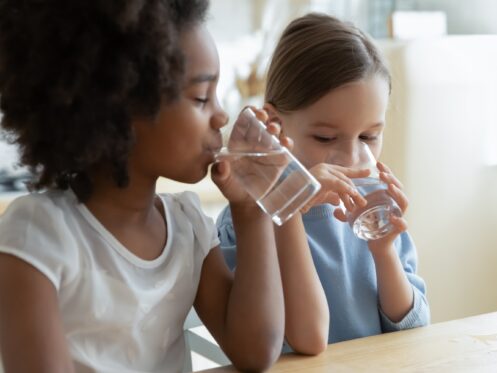Making sure your small children are safe should always be your number one concern while you have them at home. One area that’s often overlooked is plumbing. While pipes, faucets, and drains are essential to your home’s function, they can pose hidden dangers to curious little ones. From sharp edges to water temperature concerns, several plumbing hazards can be easily prevented with a few simple safety measures. Delta Mechanical in Mesa, AZ is here to help you ensure your home’s plumbing is fully childproofed with expert advice and professional services.
Secure Exposed Pipes and Fixtures
Young children are naturally curious and love to explore every nook and cranny of their environment. This can include investigating under the sink or tugging on exposed pipes. While most plumbing fixtures are designed to be sturdy, they can still be dangerous for kids if left unprotected. For example, lines that are left out in the open can be sharp or rough, making them dangerous to touch. It can also get very cold inside metal pipes, which can be painful for little hands that might touch them.
To minimize the risks associated with exposed plumbing, it’s important to secure and protect these areas. Start by installing cabinet locks on all bathroom and kitchen cabinets, especially those that house plumbing systems. This will prevent children from accessing pipes or under-sink areas where they could get hurt or tamper with plumbing supplies.
For exposed pipes that can’t be hidden behind cabinets, consider using foam pipe insulation or pipe covers. These are soft, inexpensive materials that cover the pipes and help prevent injury if your child bumps into them. Furthermore, these coverings can keep the pipes from getting too cold, adding an extra layer of protection to your home environment.
Install Faucet Covers and Locks
Another plumbing hazard that young children face is the potential to turn on faucets or adjust water temperatures accidentally. The flow of water might seem like an exciting thing to control for little hands, but it can lead to accidents, especially when dealing with hot water. Even a few seconds of hot water can cause severe burns to sensitive skin.
To prevent burns from hot water, install anti-scald devices on faucets and showerheads. These devices regulate water temperature to prevent it from exceeding safe levels. Many newer fixtures come with built-in temperature controls, but older taps can be retrofitted with separate anti-scald valves, which are typically inexpensive and effective. For maximum reliability, professional installation is recommended, particularly for devices that control the temperature at the water heater.
You should also consider installing faucet covers. Faucet covers serve as protective barriers that cushion sharp edges and reduce the risk of injuries from accidental bumps. While they don’t directly control water temperature, they add an extra layer of safety by preventing direct contact with hot surfaces. These covers, often made of soft, rubberized materials, come in playful designs that are visually appealing to children while serving as a clear safety measure.
To further childproof your plumbing, consider installing knob locks on faucets and shower handles. These devices prevent children from turning knobs and causing unexpected water flow. Knob locks are especially useful for traditional faucet designs but may not be compatible with modern single-lever handles. They are easy to install, removable, and provide peace of mind until your child is old enough to manage water temperatures safely.
Manage Water Temperature
Controlling water temperature is essential for child safety, as water hotter than 120 degrees Fahrenheit can cause serious burns in seconds. Most experts recommend setting your water heater thermostat to no higher than 120 degrees. This temperature is hot enough for daily activities but low enough to reduce the risk of scalding injuries. Use a water heater thermometer or consult a plumber to verify and adjust the temperature if needed.
If your home has a tankless water heater or experiences inconsistent water temperatures, install point-of-use tempering valves at taps, bathtubs, and sinks. These valves maintain safe water temperatures at individual fixtures, offering extra protection against burns, especially in areas frequently used by children. This makes tankless water heater installations safer for the whole family.
Childproof Sinks, Toilets, and Bathtubs
Sinks, toilets, and bathtubs are a significant focus when it comes to childproofing your plumbing. They are essential parts of your home’s plumbing system, but they also pose hazards for children. Young children are naturally drawn to water and may try to climb into the sink or bathtub, even if they aren’t capable of understanding the dangers. While you can’t remove the water altogether, you can take steps to reduce the risks of drowning.
Start by installing sink and tub guards that prevent children from climbing into them. These guards can also be used to secure the toilet seat and lid to prevent a child from falling in. Most toilet seat locks are easy to install and provide an extra layer of protection for toddlers and young children.
In the bathtub, consider using a non-slip mat or bath stickers to keep your child from slipping and falling. Slips and falls in the tub can result in serious injuries, so creating a secure environment is essential. Another option is installing a bathtub barrier, which is designed to block a child from quickly accessing the tub when water is present.
While it’s important to focus on the risk of drowning in the bathtub or sink, maintaining your plumbing system is another critical aspect of childproofing. Overflowing sinks or tubs can create slippery surfaces and increase the risk of accidents. Ensure your plumbing is functioning properly to prevent leaks or overflows, and consider using drain covers to reduce the chance of clogs caused by small objects. Drain covers also act as an additional safety measure by limiting your child’s access to standing water.
Don’t Forget Outdoor Plumbing
While you may have taken care of the plumbing inside your home, outdoor plumbing can also pose unique hazards for young children. Sprinkler systems, garden hoses, and outdoor faucets should be treated with just as much attention to safety as the plumbing inside your home. Outdoor faucets can be especially dangerous if they are located low to the ground where they can be easily accessible to children. Consider installing faucet covers on these fixtures as well or using hose bib covers to prevent children from turning them on.
Be sure to monitor any exposed irrigation systems in your yard. Pipes or hoses that are left unattended can present tripping hazards or create standing water in your yard, which can lead to accidental drowning. Store hoses in a safe, high place where children can’t access them, and regularly check to ensure they aren’t leaking or creating puddles near high-traffic areas.
Contact Us Today
Childproofing your plumbing is an important step in providing a safe environment for your children. Simple measures, such as fastening exposed pipes, fitting safety covers on faucets, and maintaining optimum water temperature, may dramatically minimize the likelihood of accidents. Regular inspections of your plumbing system, as well as educating your children about water safety, may help avoid possible risks. With these safety precautions in place, you can be certain that your house is a safer environment for your children to explore.
When you’re ready to put safety measures in place, Delta Mechanical in Mesa is ready to help. In addition to preparing your plumbing system for your littles, we offer water heater and gas line installations, kitchen and bathroom renovations, repairs, and other specialty plumbing services. Contact us today to learn more.


